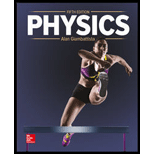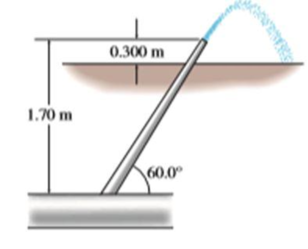
Concept explainers
A section of pipe with an internal diameter of 10.0 cm tapers to an inner diameter of 6.00 cm as it rises through a height of 1.70 m at an angle of 60.0° with respect to the horizontal. The pipe carries water and its higher end is open to air. (a) If the speed of the water at the lower point is 15.0 cm/s, what are the pressure at the lower end and the speed of the water as it exits the pipe? (b) If the higher end of the pipe is 0.300 m above ground, at what horizontal distance from the pipe out let does the water land?

(a)
The pressure at the lower end and the speed of the water as it exits the pipe.
Answer to Problem 117P
The pressure at the lower end is
Explanation of Solution
Take point 1 to be the lower end and the point 2 to be upper end of the pipe.
Write the continuity equation of fluids.
Here,
Rewrite the above equation for
Write the equation for
Here,
Write the equation for
Here,
Put the above two equations in equation (II).
Write the Bernoulli’s equation.
Here,
Substitute
Here,
Conclusion:
The atmospheric pressure is
Substitute
Substitute
Therefore, the pressure at the lower end is
(b)
The horizontal distance from the pipe outlet where the water lands.
Answer to Problem 117P
The horizontal distance from the pipe outlet where the water lands is
Explanation of Solution
Write the equation for the horizontal distance from the pipe outlet where the water lands.
Here,
Write the equation for
Here,
Put the above equation in equation (V).
Write the equation for the vertical distance through which the water falls.
Here,
The value of
Substitute
Write the equation for
Put the above equation in equation (VII).
The above equation is a quadratic equation in
Write the equation for the root of the above quadratic equation.
Conclusion:
Substitute
Time cannot be negative.
Substitute
Therefore, the horizontal distance from the pipe outlet where the water lands is
Want to see more full solutions like this?
Chapter 9 Solutions
Physics
- A U-tube open at both ends is partially filled with water (Fig. P15.67a). Oil having a density 750 kg/m3 is then poured into the right arm and forms a column L = 5.00 cm high (Fig. P15.67b). (a) Determine the difference h in the heights of the two liquid surfaces. (b) The right arm is then shielded from any air motion while air is blown across the top of the left arm until the surfaces of the two liquids are at the same height (Fig. P15.67c). Determine the speed of the air being blown across the left arm. Take the density of air as constant at 1.20 kg/m3.arrow_forwardA tank with a flat bottom of area A and vertical sides is filled to a depth h with water. The pressure is P0 at the top surface. (a) What is the absolute pressure at the bottom of the tank? (b) Suppose an object of mass M and density less than the density of water is placed into the tank and floats. No water overflows. What is the resulting increase in pressure at the bottom of the tank?arrow_forwardReview. The tank in Figure P15.13 is filled with water of depth d = 2.00 m. At the bottom of one sidewall is a rectangular hatch of height h = 1.00 m and width w = 2.00 m that is hinged at the top of the hatch. (a) Determine the magnitude of the force the water exerts on the hatch. (b) Find the magnitude of the torque exerted by the water about the hinges.arrow_forward
- A backyard swimming pool with a circular base of diameter 6.00 m is filled to depth 1.50 m. (a) Find the absolute pressure at the bottom of the pool. (b) Two persons with combined mass 150 kg enter the pool and float quietly there. No water overflows. Find the pressure increase at the bottom of the pool after they enter the pool and float.arrow_forwardThe construction of a water pistol is shown in the figure below. The cylinder with cross-sectional area A1 is filled with water and when the piston is pushed (by pulling the trigger), water is forced out the tube with cross-sectional area A2. The radius of the cylinder and tube are, respectively, 1.50 cm and 1.40 mm, and the center of the tube is a height h = 3.00 cm above the center of the cylinder. (Assume atmospheric pressure is 1.013 ✕ 105 Pa.) (a). At what speed v1 (in m/s) must the plunger be moved to achieve the desired range? (b). What is the pressure (in Pa) at the nozzle? (c). Find the pressure (in Pa) needed in the cylinder. (d). Calculate the force (in N) that must be exerted on the trigger to achieve the desired range. (The force that must be exerted is due to pressure over and above atmospheric pressure. Enter the magnitude.)arrow_forwardA pipe with an inner diameter of 2.00 cm is being used to deliver water at an absolute pressure of 4.00 X 105Pa, with constant flow speed of 1.50 m/s. It is then connected to another pipe with a diameter of 1.00 cm placed in the 2nd floor located 5.00m above the first pipe. What is the absolute pressure at the pipe in the 2nd floor?arrow_forward
- A horizontal pipe decreases uniformly from 150 mm diameter to 100 mm diameter in the direction of the flow of water. The pressure at the narrow section of the pipe is 2.2×105 N/m2, when the flow rate is 0.12 m3/s . Assuming there are no friction losses, calculate the pressure at the 150 mm side.arrow_forwardA horizontal pipe 12.00 cm in diameter has a smooth reduction to a pipe 6.00 cm in diameter. If the pressure of the water in the larger pipe is 7.50 104 Pa and the pressure in the smaller pipe is 6.00 104 Pa, at what rate does water flow through the pipes? Answer: __________kg/sarrow_forwardIn an industrial cooling process, water is circulated through a system. If water is pumped with a speed of 5.20 m/s under a pressure of 5.00*10^5 Pa from the first floor through a 3.80-cm diameter pipe, what will be the pressure on the next floor 3.50 m above in a pipe with a diameter of 3.00 cm?arrow_forward
- When connected to a standpipe, a fire hose 5.29 cm in diameter must deliver a minimum flow rate of 1.00 ✕ 103 L/min. (a) At this rate, with what speed does water leave the fire hose?arrow_forwardTo suck lemonade of density 1000 kg/m3 up a straw to a maximum height of 85 mm, what is the minimum gauge. pressure you must produce in your lungs?arrow_forwardThe pulmonary artery, which provides a horizontal connection between the heart and the lungs, is 8.4 cm long and has an inner radius of 2.6 mm. Blood within the heart is basically at rest. The density of blood is 1050 kg/m3, a little greater than the density of water. If the pressure drop between the heart and lungs is 400 Pa, what is the speed of blood in the pulmonary artery?arrow_forward
 Principles of Physics: A Calculus-Based TextPhysicsISBN:9781133104261Author:Raymond A. Serway, John W. JewettPublisher:Cengage Learning
Principles of Physics: A Calculus-Based TextPhysicsISBN:9781133104261Author:Raymond A. Serway, John W. JewettPublisher:Cengage Learning Physics for Scientists and Engineers: Foundations...PhysicsISBN:9781133939146Author:Katz, Debora M.Publisher:Cengage Learning
Physics for Scientists and Engineers: Foundations...PhysicsISBN:9781133939146Author:Katz, Debora M.Publisher:Cengage Learning

